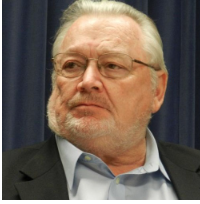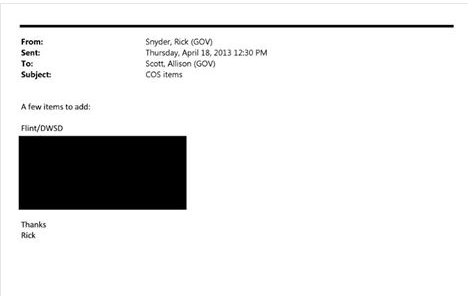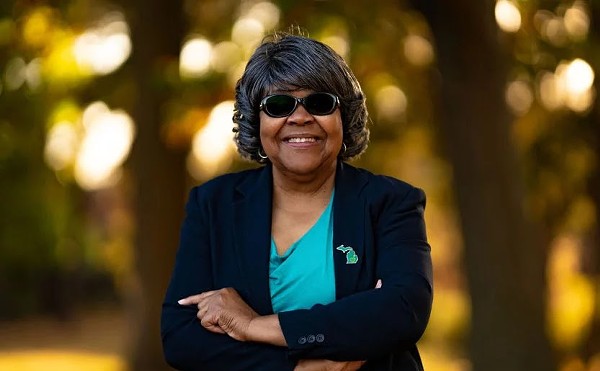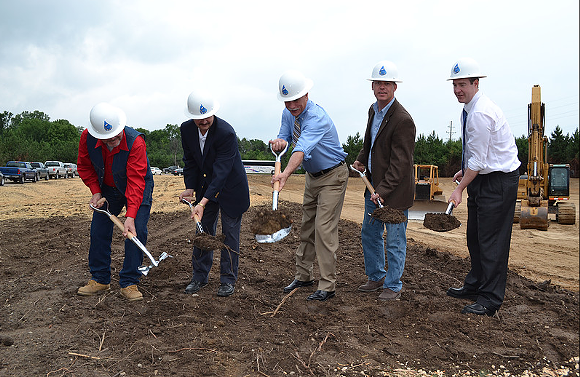
The reality raises a host of questions about the pressures surrounding the KWA pipeline — a multi-million dollar water system/construction project that Kurtz and the state were advised against joining — and once again pokes holes into the "cost-cutting," "austerity" narrative that is often tied to both the deal and role of emergency managers.
On March 28, 2013 — after months of debate over whether Flint should sign an updated 30-year contract with the Detroit Water and Sewerage Department or join the KWA — Kurtz signed a resolution to purchase 18 MGDs (million gallons a day) of water from the latter.
This may sound like "so what?" news — 'what does 18 MGDs even mean?!' — but it is in fact incredibly significant. According Howard Croft, then-head of Flint's Department of Public Works, during peak months the city uses about 13-14 MGDs. Non-peak months? 10-11 MGDs. In short: 18 MGDs is extravagant for a city with a dwindling population.
More than just excessive, though, it is costly. According to the KWA capacity contract that Kurtz signed, each MGD costs an estimated $355,300 a year. In other words, we're talking about millions of dollars that could have been saved if the resolution was more realistic about Flint's needs.
All of this brings us to the next troubling fact about Kurtz's deal: It ignored City Council's desires. While the council did vote in favor of the KWA pipeline (more on that farce in a bit), they voted 7-1 to purchase 16 MGDs, not 18 MGDs.
Video of the March 25 vote shows that many of the council members were concerned about costs for their cash-strapped city and recognized that Flint would likely not need 18 MGDs —that number was a suggestion from the Michigan Department of Environment Quality — and so they discussed plans that centered around smaller numbers.
While the council originally wanted to vote on just 15 MGDs — a figure still above the water usage during peak months — they eventually settled on 16 MGDs, saying it was a "compromise," for those like Kurtz and Mayor Dayne Walling who stressed the necessity of 18 MGDs. As the council members stated before the vote, if 16 MGDs was insufficient they could always use 2 MGDs from the Flint River and blend it with the KWA's Lake Huron water. They acknowledged that that likely would not be necessary based on Croft's stats, but that it was also not a big deal since MDEQ approved the blending plan as safe. In other words, Flint City Council left that meeting believing they found a cheap resolution for the city, and had a legit back up plan should they for some reason need more water.
Yet Kurtz ignored this. Why it was so imperative for Flint to go with 18 MGDs from just KWA was not overtly stated at the council meeting, but we are given something of clue through the video of the event. According to testimony from that evening, if Flint chose to go with anything less than 18 MGDs, the diameter of the entire pipeline would be smaller, which would hurt the amount of water the KWA could draw as a whole.
"18 MGDs to 15 MGDs would change the take diameter for the piping from 66” to 54” — that’s where savings comes from," Genesee County Drain Commissioner and KWA CEO Jeff Wright told the council after breaking down the math for them. "You started at 36 MGDs in the study and that’s what had you at $12 million annually — currently what you’re paying Detroit. When you dropped to 18 MGDs that dropped you to $6 million annually. If you dropped another 3 MGDs that’s another million dollars and that would also reduce the pipe size."
Basically, Wright inadvertently explained how if Kurtz had gone with the council's original resolution he would have saved the city $1 million a year, plus extra funds since construction costs would be cheaper with a smaller pipeline.
Of course, that wouldn't have really worked for those behind the KWA, like Wright, who also noted at the meeting that a reduction in the pipe's size would "reduce the ultimate capacity that that pipe can supply."
As we've previously reported, while the KWA was often touted as a "cost-saving" solution — likely so it could appeal to Flint residents frustrated with rising water bills — the true motivations behind the project were immensely focused on new economic opportunities for the region. Specifically, the KWA leaders were zeroing in on the sale of untreated, raw water — and lots of it. The KWA's permit from the state allows it to draw a whopping 85 MGDs from Lake Huron. This capacity, however, would not be possible if the pipeline's diameter was decreased; a fact that could hurt future business deals.
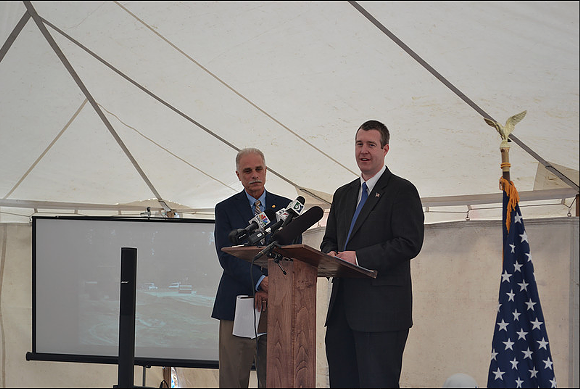
Kurtz's counter-intuitive deal, however, only begins to hint at the complicated relationships and layers of deception seemingly surrounding the KWA. This is highlighted in the fact that many did not even bat an eyelash when Kurtz did sign on for 18 MGDs. Much of this has to do with how well the KWA sold the idea that the new pipeline would most definitely be "cheaper than DWSD."
One particularly poignant moment captured at the city council meeting was when a skeptical council member, current state representative Sheldon Neeley, questioned the actual cost-savings of the KWA plan for Flint residents.
"The misperception is that if we went with this there would be a reduction in current water rates," Neeley states, asking Wright if this is in fact true.
"I don’t have any jurisdiction over Flint’s rate structure or how they charge for their water," Wright answered, later adding, "Once it’s completed in 30 months all the studies show independently that there will be several million dollar cost reductions to all the communities involved. It’s still up to those communities to decide what to do with the savings. Whether they put it back into the system to help fix leaky pipelines or they reduce their customers’ rates, or a combination of both … saving are determined by each individual community."
While Wright is not being totally honest with his statement that "all studies" show million dollar cost reductions (Tucker, Young, Jackson, Tull, an independent engineering firm hired by the state to compare the two water options found several financial flaws in the KWA plan and argued that construction would likely cost nearly $100M more than the authority was projecting), we're going to move past that and instead focus on the second part of his statement; the part that deals with who controls water bills. So much of KWA's success came from the fact that Flint residents were frustrated and angry with their rising water bills under DWSD. Wright's statement, however, points to a reality that the KWA doesn't highlight often: Individual water bills are decided by the those running a municipality, not the water system.
For example, in August 2011 — about 10 months after the KWA was incorporated — Mayor Walling, who also sits on the KWA board, raised water and sewer rates by 35 percent. Genesee County suburban residents, who also receive water from DWSD, did not experience such a hike. While water systems may raise their rates — there is no doubt DWSD's rates rose drastically over the past thirty-years, the water bills are still determined by local officials.
This is a fact that stuck with council member Neeley, who later questioned Mayor Walling about his allegiances.
"The last three rate increases that we had — two were done by your administration, and then you tell people we have to go to a better system, a cheaper system, it seems that you can motivate people or manufacture a crisis where you have to move to a different system," Neeley stated.
While Walling denied that this was the case, the fact is public perception — frustration and restlessness (intentional or not) — had already set in.
Listening to the public comments at the council meeting, you can hear the desperation in the voices of the citizens.
"In 2008 I paid $42.07 for my water bill. In 2013? $115.38," said one Flint resident holding up copies of his bills, later adding, "I think this water line is a no brainer, it’s been proved that it will save money in long run. I would rather see this board make the decision then that dictator. Good luck to you making the decision."
In reality the council needed a lot more than luck to make their decision — they needed facts. Facts beyond what the KWA said had been "proved." As became clear through the video of the council meeting, the eight public officials were asked — at last minute, no less — to weigh in on a highly-important matter with very few resources.
When speaking to Mayor Walling, Neeley brought up the fact that on several occasions he asked for the TYJT report that the state contracted in fall 2012 to compare DWSD and the KWA. The report, which was negative about the latter, was never given to the council members. What was? An effusive paper, made in response to the TYTJ study, by Rowe Engineering, the company tasked with planning the pipeline.
"I was very disappointed in the fact that your office, nor the EM office provided us with that information," Neeley said. To this, Mayor Walling stated that he and the EM, "didn’t have access to that study" and that they ultimately received it through a reporter in Detroit, who received it through the DWSD. "So what we should be asking ourselves in Flint, is how come a study commissioned by the state is up in an office in Detroit, before it ends up here," Walling said, attempting to shift the focus.
While the Michigan Department of Treasury and TYJT refused to comment when MT reached out to see if Walling was at the initial December presentation by TYJT, it is somewhat unbelievable to think players so heavily entrenched in this decision making process didn't have access to a critical study purchased by the state.
Of course, the lack of materials provided to the council is ultimately unsurprising when considering the fact that Kurtz never seriously considered their vote anyway. This was a symbolic gathering and nothing more — council members knew it too.
"How did this haphazardly land in our laps?" questioned Neeley, who advocated for the council to get more time to weigh the options after the original vote was sprung on the muted-public officials two weeks earlier.[Kurtz] relinquished power pretty easily for this decision, but there were other decisions that impacted this community that he did not even give us the opportunity to even be informed about."
Neeley mused, with the fellow council members, about the oddity in their opinion suddenly being valued.
"If [the KWA] was a bad decision or a poor decision than the state could be held liable for that decision and have to recoup the costs to the residents of the community," he stated, wondering if the council was being used as a future-scapegoat in case the KWA plan ended up being rotten.
While the KWA deal did have rotten consequences — In April 2014, while waiting for the pipeline to be completed, Emergency Manager Darnell Earley signed off on connecting the city to the corrosive Flint River — these outcomes were hardly what the council could have imagined at the time, when they were just being asked to choose between two vessels connected to Lake Huron.
Still, their fears and words could not have been more prophetic.
Years later in January 2016, Gov. Rick Snyder pointed to their vote in his State of the State address, saying that the Flint water crisis "began in spring 2013, when Flint City Council voted 7-1 to buy water from the Karegnondi Water Authority (KWA)."
The fact that their vote was essentially ignored — not to mention it had nothing to do with switch to the Flint River — was irrelevant.
Did the governor mention at the State of the State that on April 19, 2013 — weeks before Flint publicly announced that it was rejecting DWSD's offer and going with the KWA — he met with Kurtz, as well as representatives from the KWA and DWSD to discuss the options? No.
Why would the governor acknowledge the real players surrounding the approval of the KWA? He had a convenient scapegoat in the powerless, but accountable city-council. He took it.
Resolutions to purchase water from the KWA

